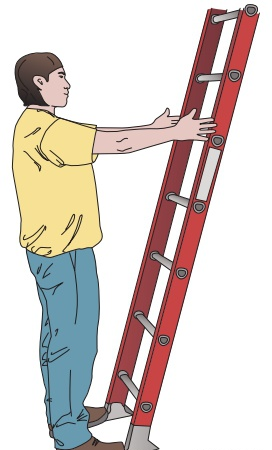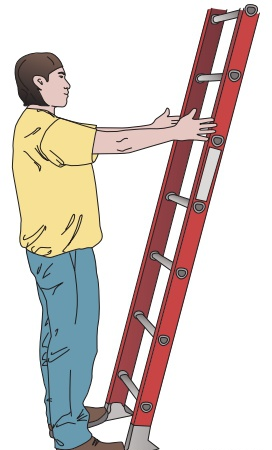How could you use the ladder correctly and safely?
A broken ceiling lamp needs to be replaced, a dirty window needs to be cleaned, and colorful night lights are hung on the eaves at Christmas. All these things can't be done without ladders.
Can you use the ladder correctly?
Before using ladders correctly, we must know about the four common properties of ladders: shape, height, bearing capacity and material, and how they affect you.
Form
Have you noticed, no matter what kind of ladder, its width is almost the same, almost the width of your shoulder? No matter how the ladder structure is designed, there are two final working forms:
One is a straight ladder and the other is an A-shaped ladder.

Let's focus on the straight ladder.
When the straight ladder works, it needs a set of supporting points up and down. Needless to say, it is the ground below; The upper part needs to be supported by, for example, a wall surface, such as a gutter.
When erecting a straight ladder, common sense tells us that it cannot be placed vertically, but it will fall down.

The safety angle of vertical ladder erection is:
The vertical angle is 15 ° , which means the horizontal angle is 75 °
Roughly 4 to 1, the ladder goes up 4 feet and the ground extends 1 foot. Notice here that 4 feet is the vertical height, and the ladder is on the hypotenuse, which is actually slightly longer than 4 feet.
If you're not sure how to do this, use this simple tip: keep your feet against the ladder and stand up straight. If your arms are just straight enough to touch the ladder, this is the right angle. If the arm is bent when the hand touches the ladder, the ladder is too straight.
The ground on which the ladder is erected must be horizontal, otherwise the ladder is placed obliquely. You don't think that if you don't stand up, the center of gravity will move up, and it is very easy to collapse. Try to erect a ladder on a level ground, or put something under one foot of the ladder.
The ladder foot shall be fixed properly, and it is best to use a heavy object to hold the ladder foot.
When climbing a ladder, you should keep your body close to the ladder. Some people feel that they are already close to the ladder. In fact, their hips are puckered for a long time. It is dangerous to shift their weight outward. It's best to stick your stomach to the ladder like rock climbing. If your legs are too long to climb, some people climb slightly sideways with their knees to one side. Anyway, try to keep your butt close to the ladder.
It is forbidden to climb from the opposite side of the ladder.
Do not stand on the top two sections of the ladder. The reason is very simple. If you stand on the top two sections, where should you hold your hands?
Another form of ladder is A-shaped ladder.
If the ceiling lamp at home is broken, the vertical ladder cannot be erected because the ceiling lamp is in the middle of the house and there is no wall around. At this time, A-shaped ladder is used. A-shaped ladder deployment is a fixed safety angle, which can be directly erected on the ground.

The A-type ladder is relatively stable in this direction of the A-type bracket, but it is still easy to flip in the side, even easier than a straight ladder. Some people mistakenly believe that A-ladder stability, for the convenience of standing on the ladder to move the ladder, causing an accident overturn.
A-shaped ladder can not stand at the top, even if you find that many A-shaped ladder top is flat.
Height
If you're going up to the roof, which means you're not content just to stand on the ladder, but to step away from it, your ladder needs to be an additional 3 feet or 1 meter above the eaves. The reason is that when you return to the ladder, you need to hand down the ladder, or it is likely to happen up and down the embarrassment, remember.
Let's do a little exercise and see how long a ladder you need if you're going to get up on the roof?
Suppose the eaves are 20 feet from the ground and the eaves are 1 foot from the wall. If we put the ladder on the eaves, the safe distance for the foot of the ladder to leave the wall is 1 + 5 feet = 6 feet, according to the 4-to-1 rule. The trigonometric function calculates that the right-angled edges are the 5-and 20-foot right triangle, meaning that the length of the ladder would need to be 20.6 feet, plus the 3-foot extension, which would require about 25 feet of ladder to reach the roof.
Here again, you go to the store to buy a ladder to see the description of the height of the ladder, is the physical length of the ladder itself? Or the height at which a man can reach from a ladder? The difference between the two“Heights” is usually three feet, or more than one meter. The two-height ladders can sometimes seriously mislead you.
The internal height of the house is about 8-10 feet, and in most cases a 6-foot A-shaped ladder can be used for the interior. If you need to clear the gutter of fallen leaves, hang colored lights on the eaves and use a higher straight ladder. The aforementioned 25-foot ladder to the roof, even the 25-foot double-jointed extension ladder, is a big deal. Note that a double 25-foot ladder is not only 25/2 = 12.5 feet high, it needs to have a long enough overlap between the two sections to ensure strength.
The higher the ladder, the less secure it is, simply because the center of gravity is higher but the ladder is not wider. Do not attempt any of the usual dangerous moves on 6-foot ladders on 12-foot ladders! If possible, ask another person to hold the ladder for you. It only takes a little strength to stabilize the ladder, which can greatly reduce accidents.
Load-bearing
Load-bearing refers to all the weights on the ladder, including the sum of the people and the things they carry. An experienced roofer won't climb up on a roof with too many tiles at once, even if he can carry them.
Material
Most ladders today are made of aluminum or fiberglass, both of which are light and strong. In most cases, you can choose either. But if you are working with electricity, glass is the preferred choice.
The advantages and disadvantages of the common ladders in the market are summarized as follows.


